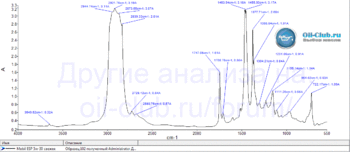This is some older (2018) information from the Russian Oil Club.
The oil is declared as: ACEA C2/C3, API SN/SM, MB-Approval 229.52/229.51/229.31; VW 504 00/ 507 00; Porsche C30; Peugeot Citroen Automobiles B71 2290; GM dexos2TM (License number D20281HC015)
1) This is really a "thirty", the oil meets the SAE J300 standard for viscosity.
2) Viscosity at 40C = 64.00 - in terms of viscosity, this oil is more economical. And from subsidence protect already, GTL, PAO,Esters and polymer thickener.
3) Viscosity at 100C = 11.72 - the golden mean between economy and wear protection. Almost all modern ACEA C3 oils now have such viscosity.
4) Viscosity index = 182 - high, precisely because they try to make the oil economical due to the lower viscosity. Let me remind you that usually ACEA C3 oils have a viscosity index of 165-170. Here, Mobil clearly went in the direction of economy, and the protective properties were realized through synthetic bases and probably a strong polymer thickener.
5) Base number = 8.61 - this is the main change between the old ESP Formula and the new ESP - the oil now has a higher base number. If earlier Mobil1 ESP Formula 5W-30 had a low base number of 6.46 and quickly lost the alkaline reserve in the workings, now ESP is improved. They increased the base number, the oil began to have a large margin for neutralizing acids and work longer before operation.
6) Acid number = 1.48 is a very good change (unless of course the difference in testing between laboratories.). A low acid number will take longer to grow during mining. The oil will work more slowly. With a high base number = 8.61, a low acid number has even more promise.
7) Sulphate ash content = 0.89 - the requirements of the ACEA C3 standard are exceeded, where the ash content should be = < 0.8. Maybe it's the fault of the lab's measurement, like an example of double-checking ash content — because it's not very similar to Mobil. Maybe the matter is too high in the content of calcium and the miracle did not happen - the ash content climbed up. In general, this is a subject for discussion.
8) Flash point = 242C - the high flash speaks for itself, firstly the oil is very thermostable at high temperatures, the second oil really consists of GTL base oils synthesized from gas - they give the oil the properties of thermal stability. Of course, in view of this, NOACK will be very low - you can not guess, it is clearly 6-8%.
9) Pour point -50C - excellent pour point, shows the properties of synthetic base oils that make up Mobil1 ESP 5W-30. The manufacturer itself states -48C, between -50C and -48C the difference is not large, especially with different methods of determination. On this oil can not freeze even in a fierce frost. The only thing you need to remind is that on the oil 5W-30, you need to start the engine to -30C - the viscosity of scrolling with the starter has not yet been canceled.
10) Sulfur content = 0.195 - lower than that of most odnoklassniki oils. Of course, such a low sulfur content gives, including a pure GTLbase.
11) As I said above, the oil is sharpened for fuel economy, in this it is additionally helped by organic molybdenum MoDTC - reducing the coefficient of friction, wear and noise of the engine.
12) Anti-wear additives based on phosphorus and zinc, boron in the form of an ash-free dispersant and I suspect some other additive, anti-wear or detergent, one can only guess. Calcium is responsible for detergent/neutralizing properties - it is a detergent.
13) Oxidation parameter 34.3 - makes it clear to us that the oil contains esters.
Fourier's IR spectrum presumably suggests that the oil is based on GTL + Estera. (There are probably a few more PAOs and VHVI.) It is synthetic.
 Conclusion:
Conclusion: Again, Mobil1 produces an advanced, high-tech oil unlike any other brand. The main changes compared to the old ESP Formula are as follows - even cleaner and more synthetic base oils, even higher detergent/neutralizing properties, even more margin before discharge, even more fuel economy. The oil has good thermal stability at high temperatures. Due to molybdenum, low viscosity, esters, gives even greater fuel economy. Due to the syntheticity of base oils, it has decent low-temperature characteristics and does not save in frosts. To protect the engine from wear, there is a whole arsenal - molybdenum, anti-wear additives ZDDP,Esters, thermostable base, I suspect also not a simple polymer thickener + anti-wear additives based on boron. The only drawback, if this is of course the correct data - the ash content is overestimated.

